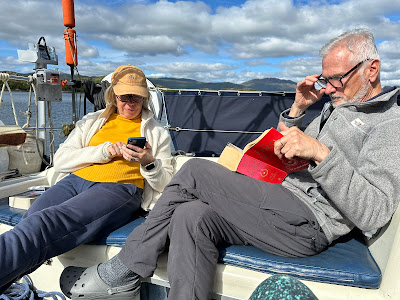In 2006, when we set off in the general direction of the Mediterranean, we carried three anchors on board Kalessin. We had the original CQR, a Delta as a spare, and Fortress as a kedge. For some reason that I can’t remember (perhaps because we had a CQR on our previous boat), we continued to try anchoring with the CQR for the whole of that season, not entirely successfully. We were fine off Sark and other locations, slightly uneasy in the Morlaix river, and dragged in the Morbihan, although to be fair our anchor may never really have touched the bottom.
Over the winter, we went to the London boat show and talked to someone on the Rocna stand about getting one of their anchors. At that time, they were still being personally imported from New Zealand. Far from giving us a hard sell, the chap suggested that we try the Delta for a season, and if we weren’t happy with it come back to him afterwards. The Delta proved much easier to set, and has been pretty reliable, even on one memorable night in Menorca, where we were rolling through a substantial angle, and the anchor didn’t budge. But somehow, I have never really been confident about anchoring then or subsequently.
In Scotland, you really have to be able to anchor to make the most of the many fabulous empty lochs and inlets. So from Tobermory, we decided to head an adventurous five miles to Loch Drumbuie, which is a very sheltered loch within another loch, and a popular anchoring spot.
Five miles would not take us very long, so I had plenty of time to inflate the dinghy in advance, flake out and mark the anchor chain with cable ties, and explain the process to Alex and David. Alex has done this before, but David, as a scientist, wanted to make quite sure that he understood, which took a while.
 |
| Relaxed crew (unlike the skipper) |
Anyway, the loch was much emptier than we had feared, with initially only two or three boats around the perimeter, although a few more came in later, and anchoring went completely to plan. David spotted a sea eagle, a golden eagle, several seals, and other interesting birds, so he was very happy. And it was a glorious afternoon and evening, with sunshine and blue skies, very little wind, and enough wind to bask in the cockpit, even with no tent up.
As we went to bed, unfortunately, the wind started to get up quite a bit more, and we were veering around a fair bit in the gusts. In my bunk at the front of the boat, the noise of the anchor moving in its roller was very loud, so of course I didn’t really sleep. I spent part of the time checking on an anchor watch app that I had downloaded to my phone (pleasingly, the stronger the wind, the less we moved in relation to the anchor), and reading up about anchor snubbers, which would have reduced the chain noise considerably. We have a snubber on board, and I have now found it, but I didn’t think I could find it and set it at 1am. Around 2:30 am the tide changed, and the motion of the boat became much more settled, so I did manage to get some sleep.
The plan for the next day was to return to Oban, before heading further south. It is a bit disappointing not to be heading up to Skye and the Hebrides, but the weather is so unsettled, I really don’t feel that I or the crew would be up to dealing with the exposed waters. Anyway, Alex had suggested that we try Kerrera Marina, which is across the bay from Oban, on its own small island.
We set off from Loch Drumbuie around 8am in fairly grim conditions, with absolutely black skies presaging a lot of rain, and a gusty wind from the south east, which was exactly where we were going. I was all set to retreat to Tobermory if conditions in the Sound of Mull had been too unpleasant, but in fact the sea was relatively smooth, and with the tide going in the right direction, we were able to motor into the wind, with the main up to help us a little bit, at around 5 kn.
 |
| Oily calm at Lismore island |
Off Lochaline conditions suddenly worsened, with the wind gusting up over 20 kn, an unpleasant chop in the Sound, and our speed dropping below 4 knots. I decided to press on for a short while and see if conditions changed. And boy, did they change. Within half an hour the wind had dropped completely, and as we passed Lismore Island, there was an extraordinary mixture of mist and fog over an oily smooth sea. We had absolutely no problem in reaching Kerrera, and docking in the exact berth that we had already booked.
Anyway, the marina proved an excellent choice, with a really nice relaxed vibe that reminded me of other small marinas like Tollesbury or Titchmarsh. The island is small but very beautiful, with plenty of walks and wildlife. We decided to stay for a second night to make the most of it, and on the Tuesday Alex and I popped over to Oban to enjoy the thrills of Tesco all over again. Late on Wednesday, strong winds are forecast for a couple of days, so we will go from here to Ardfern, a favourite of several CA members, which should offer us not only shelter but also the chance for me to catch up with some work.
Distances run, Tobermory to Loch Drumbuie, 5 nautical miles; from the Loch to Kerrera, 25 nautical miles.
 |
| The marina |
.







No comments:
Post a Comment